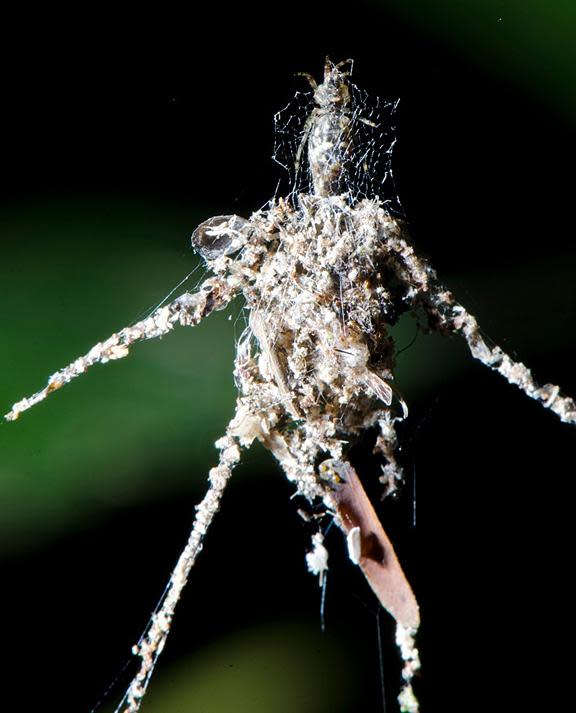Five Strangest Wonders of the Peruvian Amazon
OutdoorHub 03.05.13

Peru’s visionary leader in sustainable tourism, Rainforest Expeditions http://www.perunature.com/, shares five creations ranging from a caterpillar that’s a carbon copy of Donald Trump’s wig to triple rainbows that visitors can experience while deep in the Amazon jungle.
Three day tours available from $375 per person double will reveal some of these surprises, promises Jeff Cremer, company spokesperson and resident photography specialist.
One of Rainforest Expeditions’ three eco-lodges, the Tambopata Research Center (http://www.perunature.com/tambopata-research-center.html) focuses on one of the top wildlife spectacles of the world, the largest known clay lick in the Amazon, frequented by hundreds of parrots, parakeets and macaws. It is just a five-minute boat ride from the 18-room eco-lodge. A wall of clay over 200 feet across draws hundreds of 13 species of parrots, parakeets and macaws every morning to feed on sodium-rich clay.
Other surprises include the only known location of a recently discovered decoy-building spider that constructs a bigger, scarier version of itself on its web from debris and dead insect parts. These false spiders likely serve to make effective decoys that confuse predators. “We’ve never seen anything like this before,” claims Phil Torres, a Cornell-educated biologist who found the spider while taking wildlife photos in September 2012 near the Tambopata Research Center.
Donald Trump’s wig comes to mind when happening on the caterpillar of a megalopygid moth. The yellow fuzzy hairs are full of urticating spines that can inject a very painful poison if touched. This caterpillar was spotted at the Posada Amazonas Lodge.
The incredible woven lattice structure of the urodid moth’s cocoon is an astounding example of art in nature. The cocoon dangles from asilken string about a foot long, likely to prevent ants from feeding on it, and the bright orange color serves as a warning to potential predators that this cocoon may be poisonous to eat. The adult moth eventually emerges from the pupa, exiting through the tubular ‘escape hatch’ at the bottom of the structure. This pupa was seen at Refugio Amazonas Lodge.
Imagine seeing in the distance an upside-down rainbowabove the trees. A recent sighting of this rare optical event resulted in the best photos ever taken of this unbelievable,rainbow-filled display. These solar halos result from interactions of the sunlight with ice crystals high up in the atmosphere, and according to experts, Tambopata just happens to offer the right conditions to make this the most impressive sighting of these halos ever recorded.
Rainforest Expeditions has since 1989 created a work-in-process for sustainably exploring the miracles of the Tambopata–Candamo Reserved Zone, 1.5 million hectares of pristine, still-wild tropical rainforest encompassing an area of land the size of Connecticut and stretching from the Andean highlands to the Amazon lowlands.
Rainforest Expeditions is a Peruvian company that through conservation and ecotourism is helping to protect some of the last untouched lowland and premontane tropical humid forests in the Amazon.
Guests of first one and now three Rainforest Expedition eco-lodges have added value to the region’s standing tropical rainforest. A sensitively conceived and managed (in some cases by native communities) touristic infrastructure creates a competitive alternative to such unsustainable economic uses as clear cutting the forest for timber or for cattle grazing. The partnerships Rainforest Expeditions has forged with local people eager to share Amazonian traditions with guests provide connection, expertise, adventure and access to wildlife in the jungles of Tambopata. Rainforest Expeditions has been verified and certified “a sustainable tourism business” by the Rainforest Alliancehttp://www.rainforest-alliance.org/.
Rainforest Expeditions’ string of three jungle lodges is accessed from Puerto Maldonado airport with flights arriving daily from Lima or Cusco. Motorized wooden canoes then take guests on a 45-minute trip to the first lodge, Posada Amazonas. Refugio Amazonas, the second lodge, is a 3.5-hour boat trip from Puerto Maldonado. The third and most remote is Tambopata Research Center, requiring a 4-hour additional upriver boat ride from Refugio Amazonas. Each lodge is only a few minutes on foot from the river bank.

